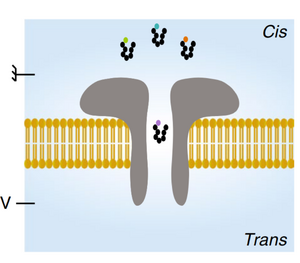Template:Researchentry
researchentry|Topic|Picture|abstract
Using ESPResSo we are investigating many different systems, especially in confined geometries, like the transport properties of ionic solutions in nanopores during DNA translocation, electro-osmotic flow in slit pores and properties of suspensions of confined charged colloids, in particular in slit and cylindrical pores. more...
have a melting point below 100°C. ILs have been known for more than 90 years, however, recently found members of this class have shown promise in applications in electrochemistry, analytics, technology, and engineered fluids. Many ILs are liquid at room temperature, with some freezing at temperatures around -90°C. Due to their salt like structure they usually exhibit a negligible vapor pressure up to high temperatures, making them particularly suited for "green chemistry". IL's also exhibit interesting solvation or coordination properties, suggesting that one could potentially use them as "designer solvents". more...
processes in porous media. Despite that fact fundamental concepts of twophase flow on macroscopic scales still remain unclear. The predictive power of the most commonly used extended multiphase Darcy theory is at best limited to simple problems where neither hysteresis nor dynamic effects like trapping nor varying residual saturations have a substantial impact on the solutions. more...

Biologische Makromoleküle erfüllen lebenswichtige Aufgaben im menschlichen Körper. Als Energielieferanten, Stoffwechselakteure, Bioroboter oder Signalbotschafter zwischen den Organen und für viele andere Stoffwechselvorgänge sind sie essentiell. Umso wichtiger ist die Erforschung deren Wirkungen und Strukturen, um beispielsweise Krankheiten besser zu verstehen und die genaue Wirkungsweise und Entwicklung von Medikamenten zu optimieren.
Biologische Makromoleküle erfüllen lebenswichtige Aufgaben im menschlichen Körper. Als Energielieferanten, Stoffwechselakteure, Bioroboter oder Signalbotschafter zwischen den Organen und für viele andere Stoffwechselvorgänge sind sie essentiell. Umso wichtiger ist die Erforschung deren Wirkungen und Strukturen, um beispielsweise Krankheiten besser zu verstehen und die genaue Wirkungsweise und Entwicklung von Medikamenten zu optimieren.
In der letzten Dekade ist es Forschern gelungen, eine effiziente und kostengünstige Methode zu entwickeln, um die Bausteine der DNA und RNA mit einzel-molekularer Auflösung und höchster Genauigkeit zu sequenzieren. Auf diesem Meilenstein aufbauend setzt sich das Zukunfstcluster nanodiag BW zum Ziel, diese Methodik der Makromolekülsequenzierung auf Proteine und Peptide zu erweitern.
Bei dieser Technik befindet sich das Analyt in einer Salzlösung, welche durch eine impermeable Lipid-Membran-Schicht getrennt ist. Diese Membran besitzt weiterhin eine Nanopore, die die zwei getrennten Hälften miteinander verbindet und somit die einzige Transportmöglichkeit von Atomen, Ionen und Molekülen auf die jeweils andere Seite darstellt. Eine extern angelegte elektrische Spannung führt nun zu einem elektrophoresischen Transport von Ionen und Analyt. Die Präsenz des Analyts in der Nanopore hat aufgrund verschiedenster atomistischer Wechselwirkungen mit allen möglichen Beteiligten schließlich eine temporäre Reduzierung des Leerstroms zur Folge, also des Ionenflusses unter der Abwesenheit jeglicher zu untersuchender Moleküle.
Anwendung von ML-Methoden
Aus der Information der Dauer und Stärke dieses sogenannten Blockadenstroms soll mithilfe modernster Machine Learning Algorithmen auf die Sequenzierung des zu untersuchenden Proteins oder Peptids geschlossen werden. Dabei werden experimentell bestimmte Sequenzierungsdaten analysiert, um auf unterschiedliche Analyte zurückführende Merkmale zu identifizieren. Als Teil des nanodiag BW Clusters ist unser Ziel die Erstellung einer Software, welche die Trainingsdaten lädt, sorgfältig analysiert und hervorstechende Merkmale extrahiert, um eine reproduzierbare und transparente Datenauswertung zu ermöglichen.
All-Atom und Multiskalensimulationen
Um die Auswirkungen des Analyttransports auf den Ionenstrom auf atomarer Ebene zu verstehen, führen wir molekulardynamische und Multiskalensimulationen der Peptid-Poreninteraktion durch. Die gewonnenen Erkenntnisse sollen der Optimierung der Porenproteine dienen, die schließlich qualitativ hochwertigere Messergebnisse ermöglichen.
Black Forest Nanopore Meeting
During the Black Forest Nanopore Meeting, we present a poster titled "Using Molecular Dynamics Simulation as a Microscope of the Peptide's Translocation Process through an Aerolysin Nanopore", where we show the latest results of the SRASKYRRRR peptide translocation through a wild-type aerolysin pore. An example of such a translocation is shown in the video below, which can be downloaded and viewed on your smartphone and other devices.
File:SRASKYRRRR translocation.avi
Kontakt
Für Fragen bezüglich der molekulardynamischen Simulationen steht ihnen Michel Mom (mmom(at)icp.uni-stuttgart.de) zur Verfügung. Unser Ansprechpartner für Fragen zum Thema Machine Learning ist Julian Hoßbach (jhossbach(at)icp.uni-stuttgart.de). more...
industrial and scientific applications. Computer simulations require accurate three-dimensional microscopic structure data as input and efficient numerical algorithms for fluid flow simulations. Natural porous media such as carbonates and clay filled sandstones exhibit heterogeneities on many scales and cannot be modeled by existing modeling techniques. more...







